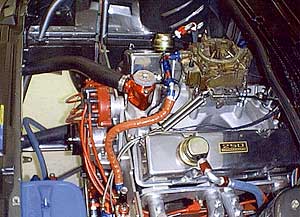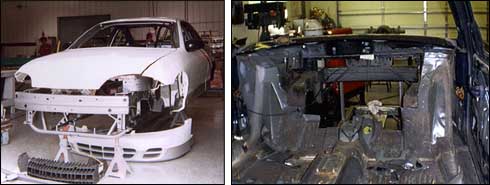
Gary Hettler (the
winningest Super Stock engine builder in
the country) built two 250-hp 327 c.i. engines.
|

Jere put me in touch with engine builder Gary
Hettler. Red Roberts at McLeod Industries set
us up with two Soft Lok clutch assemblies and
George Maxwell at Jerico got us two four-speed
transmissions. Jere recommended a RacePak V-500
data recorder and which "bells and whistles"
should be on our system.
Our wish-list was very long, but I decided
that if the rulebook didn't say you couldn't
do it and if we could get it approved by NHRA,
then I wanted it in the Cavalier. There were
many items on my list that NHRA rejected. This
"'70s" approach to building the racecar would
come back to bite me in the butt big-time later.

| The Cavalier
was built by Mark Lynn of Jerry Bickel Race
Cars. |
The paint
job caused no problems. |
The project was considerably more labor intensive
than JBRC had anticipated and the delays associated
with getting NHRA's approval on every aspect
of the new car's construction extended the process
even longer. Bickel assigned the project to
Mark Lynn, who had done most of JBRC's prototype
chassis for 17 years. Lynn built the car in
his own home shop.
In June 2003, the Cavalier was complete and
ready to race. For the amount of money I had
invested in the Cavalier, I could have bought
two Bickel Pro Stockers.
We took the Cavalier to a divisional event
at Atco, NJ for inspection. Tech inspectors
Bob Lang and Curt LaShure had my trick Cavalier
spread out all over the scale area. The interior
and dash were out and the hood and trunk were
open. As Bob and I stood side by side looking
over the car, he said, "Len, your Cavalier is
really nice and it's really safe. Unfortunately,
it's just not a Super Stocker."

| The carbon
fiber seats were rejected by NHRA. |
They didn't
like the composite dash either. |
The letter from NHRA cited 14 items that needed
to be changed before the car would be allowed
in the class. The carbon fiber seats needed
to be replaced, a hood seal was missing, some
carpeting was missing, the pedals needed to
swing from the top, the steering column was
just a bit too long, and so on. They also questioned
the use of a composite dash and our use of heim
joints on the front of the lower control arms
for adjustment.

|